





PHOTO GALLERY

Photos by Len Blumin
1. Greater Roadrunner vs. Chevy Pick-up truck

As some of you know, I take some pride in avoiding shots of captive birds, nesting birds (excepting those taken at a good distance), and birds on feeders or other artificial structures. Well, if you've ever seen a Greater Roadrunner (Geococcyx californianus), your sighting is likely to be like mine, which is a fleeting glimpse, perhaps followed by a distant scope view of a perch. So please grant some slack for what follows.
Traveling through the Panoche Valley recently (Patti and I were trailing a car with Don Reinberg and Michael Stevenson), we heard the excited cry of "ROADRUNNER!!". A large bird darted across the road and disappeared into the adjacent farmyard parking area. That's a typical Roadrunner sighting, about 2 seconds! Well, next we hear from Michael, "It's on the pick-up truck!". So we stop, and look, and sure enough it's a handsome Greater Roadrunner (Cuckoo family - Cuculidae). So we quietly exit the vehicles and set up our scopes to watch. Well, 15 minutes later we left, with the Roadrunner still there on the Chevy 1500 pick-up, hammering away at the windows in a valiant effort to drive away the interloping Roadrunner, which you can see in the window.
Funny, but the bird species I have seen most often spending endless energy attacking their reflections, all begin with the letter "R". So I am adding Roadrunner to my short list of mirror birds, which started with Robin and Raven.
2. Long-eared Owl
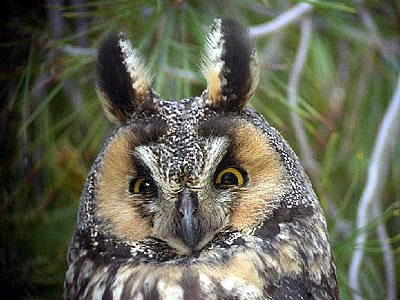
The Long-eared Owl (Asio otus) is not often seen in the Bay Area (at least not by me), but if you visit Mercy Hot Springs in Little Panoche Valley you are virtually guaranteed to see them. Some Long-eared Owls are present there virtually year-round, and up to 60 or so were there recently, perching quite contentedly in trees that are cheek-by-jowl to the public areas. This one opened his eyes briefly to check us out, but seemed quite unconcerned by our presence.
3. Great Horned Owl, Muddy Hollow, Marin County
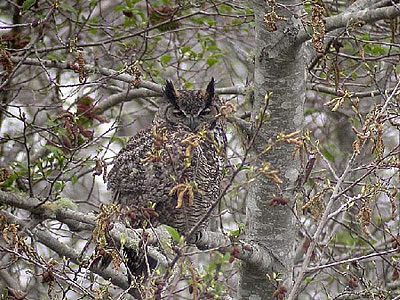
This Great Horned Owl was roosting in an Alder grove at the north end of Muddy Hollow pond. Guess he figured the Alder catkins provided some "cover" .
4. Lark Sparrow in Spring - Mt. Burdell
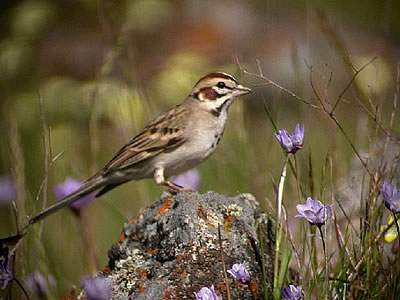
We were hoping to find a Grasshopper Sparrow at Mt. Burdell, but we had to "settle" for some Lark Sparrows, Western Bluebirds, Acorn Woodpeckers and about a zillion wildflowers. The Lark Sparrow (Chondestes grammacus) was singing lustily from a rock perch, no doubt extolling the beauties of the nearby Blue Dicks, Cream Cups and lichens. Or maybe just proclaiming, "this rock is mine!". Not the sharpest photo, but sent as a reminder to get out and smell the flowers.
5. Lark Sparrow, Mt. Burdell, Marin County
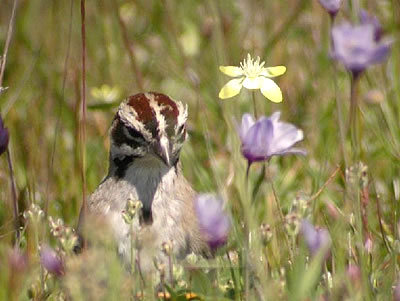
Just in case you didn't see the Cream Cups, this closer view gives you a taste. Here the Lark Sparrow is showing his median crown stripe. Cream Cups (Platystemom californicus) are in the Poppy Family (Papaveraceae).
6. Red Knot
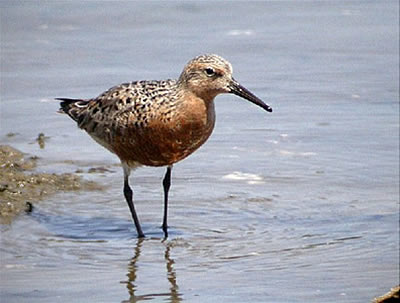
The Red Knot (Caladris canutus) is not seen all that often on the West Coast, mostly because populations were devastated years ago by market hunters. Those that remain are easily missed by casual birders like me, as they blend in with larger flocks of similar looking shorebirds like Dowitchers. Right now some Red Knots are passing along the coast, having largely molted into breeding plumage. The striking rufous chest is similar to the Dowitcher's, but the back is lighter and can be quite striking (wait for Red Knot #2). The bill helps distinguish them too, but since these birds feed almost non-stop to store energy for the flight north, it can be difficult to see. These are remarkable birds, nesting in the high arctic tundra, and then flying as far south as the Straits of Magellen for the winter. Round trip: 19,000 miles!
This is not your "winter knot", a rather drab and ordinary shorebird with no real distinguishing features. Don't wait too long if you want to search for them. South Bay may be a good spot (Foster City), but this one was in Bodega Bay on the shore before Spud Point Marina.
7. Two Red Knots
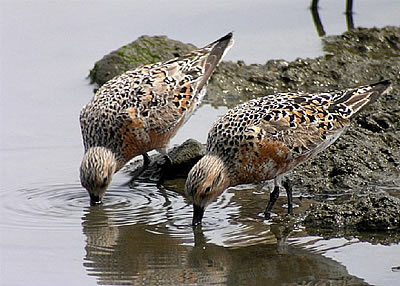
The Red Knots like to hang out together, and are said to "pack" more closely than other shorebird species. We watched two of them feeding for about an hour, and they were rarely more than three feet apart, working their way through a flock of about 500 Dunlin and Dowitchers. Their feeding style helped us pick them out, as they drilled more rapidly (perhaps 5-10x/sec.) than the dowitchers, and with a more shallow probing. Their reddish heads were often a blur, as you can see from the photo here. The color and pattern of the backs (wings) is most becoming.
The name "Knot" is said to derive from "Knut", which in term is a shortened form of King Canute, the Danish ruler who told his subjects he could hold back the tide. Of course he failed, as planned, and proved to them that he was only human after all. Not a bad name really, since these birds do feed right at the tide line. Of course the Latin name Calidrus canutus has the same origin.
TOWHEE.NET: Harry Fuller, 820 NW 19th Street, McMinnville, OR 97128
website@towhee.net